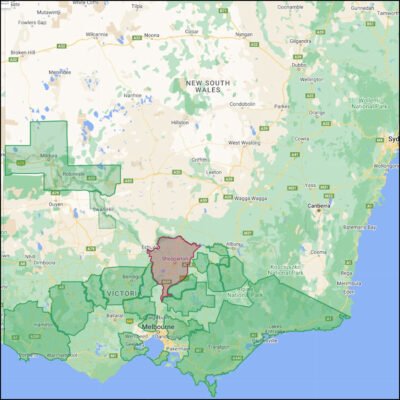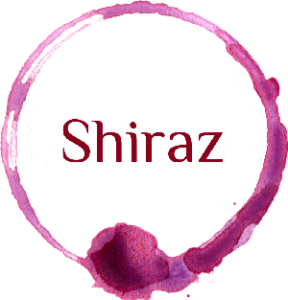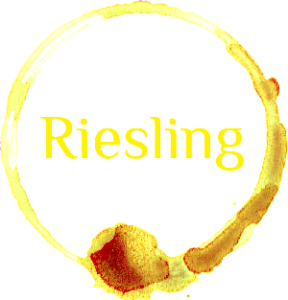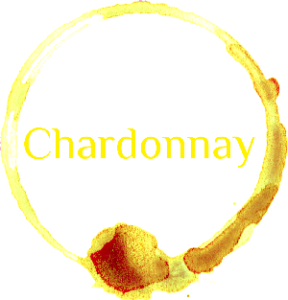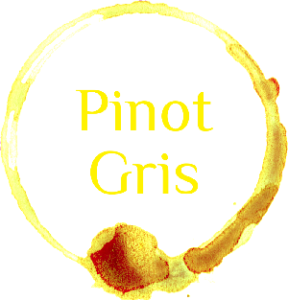The Goulburn Valley wine region forms part of Victoria’s Central Victoria wine zone alongside Bendigo, Heathcote, Strathbogie Ranges, and Upper Goulburn. It centres around the town of Shepparton, a two-hour drive from Melbourne.
The regions of the Central Victoria Zone are on the inland, or northern, foothills of the Great Dividing Range, which swings west and starts to lose altitude as it nears Melbourne. Cold nights offset warm days, although rainfall remains winter/spring dominant, making irrigation essential.
Winemaking in the Goulburn Valley began in the mid-19th century, with European settlers recognizing the valley’s unique conditions for grape growing. One of the pioneers, Tahbilk Winery, was established in 1860 and remains one of the oldest family-owned wineries in Australia. The underground cellars at Tahbilk Winery have remained unchanged since the 1800s, making them a living piece of Australian wine history. The Purbrick family purchased Tahbilk in 1925, and it was, at one point, the only operating winery in the region as Phylloxera ended all other small wineries. The only other significant winery to be established in the Goulbourn Valley was Mitchelton in 1969, which is renowned for its Riesling and breathtaking views of the Goulburn River.
The region enjoys a Mediterranean climate, ideal for growing grapes. Warm to hot summers and cool evenings allow grapes to ripen fully while maintaining their acidity. Rainfall is moderate, and the soil types range from sandy loams to rich, volcanic soils, giving the wines a distinct minerality and complexity. The presence of the Goulburn River also plays a crucial role, providing much-needed irrigation and moderating the temperature during the growing season.
The Goulburn Valley produces a wide range of grape varietals, each with a distinctive character. Its claim to fame, however, could be that it is home to the world’s oldest-producing Marsanne vines, some of which date back to 1927.
Whether you’re a connoisseur or just beginning your wine journey, the Goulburn Valley offers a wide range of wine-tasting experiences. From intimate cellar doors to large vineyards offering guided tours, there’s something for every wine lover. Don’t miss the annual Shiraz Festival, where local vintners showcase their best blends.
Top Stats
Harvest
Early Mar to early May
Mean Jan temperature
21.2°C
Area of Vine
1,263 hectares
Altitude
86 – 411m
Growing season rainfall
258mm
Principal Varietals
Goulburn Valley has historically been primarily known for its full-bodied red production, but whites are catching up. In 2023, the split of Red vs. White production was 49/51, with whites taking the lead.
However, Shiraz is still the most dominant and widely planted varietal, which made up 27% of the crush in 2023. The varietal benefits from the region’s hot summers and cool nights, allowing it to develop rich flavours and lead to bold and full-bodied wines.
Second place goes to Riesling, with 19% of the crush in 2023. Whilst Victoria isn’t particularly known for Riesling, the continental climate of the Nagambie Lakes sub-region produces consistently good wines, with Mitchelton wines leading the way.
Cabernet Sauvignon and Chardonnay are produced in equal portions, with 13% of the crush each. Cabernet Sauvignon thrives in slightly cooler areas and prefers the rich, loamy soils of the valley. The climate’s temperature variation enhances the development of its complex structure. Chardonnay does well in the moderate climates of the Goulburn Valley, where warm days and cool nights maintain acidity and balance in the grapes.
Pinot Gris sneaks into fifth place with 5% of the crush but with other varietals hot on its heels. Pinot Gris from this area is generally medium-bodied and can develop a slight richness on the palate, making it versatile and appealing for a range of food pairings. Goulburn Valley winemakers often produce Pinot Gris in a dry style, though some may experiment with varying degrees of sweetness or skin contact for added complexity.
Noteable Varietals
Marsanne is one of the most distinctive and important white varietals in the Goulburn Valley. The region is home to some of the oldest Marsanne vines in the world. The grape thrives in the valley’s warm climate and sandy, well-drained soils. Marsanne wines from this region are known for their floral and citrus aromas when young, evolving into richer, honeyed and nutty flavours as they age. The versatility and ageability of Goulburn Valley Marsanne make it a standout in the Australian wine landscape.
The region has also embraced several other lesser-known and experimental varietals:
Roussanne – Often blended with Marsanne, Roussanne produces elegant wines with herbal and floral notes. Its crisp acidity complements the richer texture of Marsanne, making the blend a popular choice for local winemakers.
Viognier – This aromatic white grape is known for its rich, full-bodied wines with floral and apricot characteristics. Viognier does well in Goulburn Valley’s climate, offering wines with depth and intensity.
Tempranillo – A Spanish red variety that has adapted well to the region’s hot climate, Tempranillo produces wines with ripe red fruit flavours and a smooth, tannic structure.
Sangiovese – Known for its versatility, Sangiovese thrives in Goulburn Valley’s Mediterranean-like conditions. It delivers medium-bodied wines with bright acidity, cherry, and earthy notes.
Durif – Goulburn Valley’s warm climate also supports Durif, a robust red grape known for producing deeply coloured, bold wines with blackberry, plum, and peppery flavours.
Source: www.wineaustralia.com



